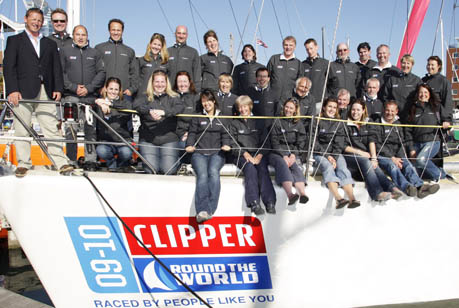California's hell in 50 knots
Having been alerted to a problem on California after they activated their EPIRB yesterday afternoon a clearer picture of the team’s dismasting is now beginning to emerge.
Fellow competitor Jamaica Lightning Bolt has rendezvoused with the dismasted yacht and skipper, Pete Stirling, was able to talk to California’s skipper, Pete Rollason, via VHF radio. The skipper explained how the yacht had come to lose her mast and reported that at 15.45 GMT on Sunday 21 March, the 68-foot racing boat was hit beam on by a very large sea coming from the port side. The impact caused the boat to roll to starboard through approximately 120 degrees and as the yacht righted herself (as she is designed to do), the mast was broken in two places.
With storm force winds blowing in excess of 50 knots, California was sailing under a very conservative sail plan with just the storm jib hoisted. During the roll, a large amount of water came through the main hatch and flooded the navigation station, cutting off the boat’s communication systems. The EPIRB ensured that the relevant authorities would be quickly aware and that the incident could be communicated.
Clipper Race Chairman, Sir Robin Knox-Johnston says, “Masts are not designed to go through water. It’s a medium hundreds of times more dense than air. So when a mast goes into the water the chances are it will break. This appears to be what has happened to California.
“I had a similar experience 20 years ago in the Atlantic and when my boat, Suhaili, came upright we had lost both masts. We had to cut them away to avoid damage to the hull and then we set up a jury rig using the main boom as a mast. Under a small sail we managed to average 100 miles a day for the 1,400 miles downwind to the Azores, without any communication or navigation electronics so it was back to the sextant. 20 years on, not much has changed and the sensible course is for California to sail downwind to San Francisco. If we can get fuel transferred from some of the following boats she will be able to motor if the wind goes light to maintain a good average speed.”
.
Crew member Clive Cockram was sitting in the portside saloon seat at the time of the incident and as the boat rolled, he was thrown across the saloon before hitting his head on the galley serving hatch. The impact caused a number of cuts to his head but they have now been attended to and he appears to be in good spirits. Other crew members suffered some minor abrasions and bruising but nothing that can’t easily be dealt with on board. The crews were eager that their next of kin should be informed and were comforted to learn that this has already taken place.
Pete Rollason and his crew set about cutting rigging away from the deck area and the yacht still has a functioning mast to the height of the first spreader. There is a second severed section which is currently angled at 45 degrees but is being held securely in place by the rigging. When conditions calm (the next 48 hours will see lighter winds as a high pressure system passes over), the team will set about removing this section and plan for a jury rig. In the VHF exchange, Pete was reported to be sounding ‘upbeat and optimistic’.
The engine is fully operational and for the time being, they are making headway under power. The two boats agreed to have a further discussion later on today as the clean up operation continues. With California presently 12 hours behind GMT the crew are awaiting daylight to further assess the situation and start preparations to jury rig the boat. The Nord Nightingale, a 180-metre tanker on passage from Yokohama to Los Angeles and diverted by US Coastguard last night, is expected in the area early evening UK time and will also offer what assistance is practical.
The Clipper 09-10 Race started from the Humber on the north east coast of England on 13 September 2009 and will return to there on 17 July 2010. It is the only event in the world where people from all walks of life can take on the challenge of a lifetime and race around the globe on stripped down 68-foot ocean racing yachts.




